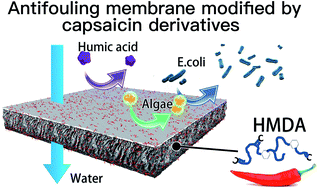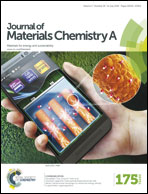A novel long-lasting antifouling membrane modified with bifunctional capsaicin-mimic moieties via in situ polymerization for efficient water purification†
Abstract
Capsaicin-mimic materials are promising candidates for antifouling membrane fabrication. However, the membrane fabrication is usually complicated and the long-term operation of the resulting membrane is unstable. In this work, we developed an “in situ polymerization-blending” technique to prepare capsaicin-containing polysulfone membranes. This facile one-pot synthesis applied a capsaicin derivative containing two carbon–carbon double bonds (N-(2-hydroxyl-3-methyl acrylamide-4,6-dimethyl benzyl) acrylamide, (HMDA)). The presence of carbon–carbon double bonds enabled the self-polymerization of HMDA, leading to stable anchoring of the capsaicin derivative on the membrane. The composite membrane exhibited higher pure water permeability (up to 3124.7 L m−2 h−1 MPa, over two times higher than that of the pure membrane) without compromising the humic acid rejection efficiency. In addition, the composite membranes also exhibited significantly improved resistance to organic fouling (humic acid) and bacteria (E. coli)/algae (Prorocentrum donghaiense) growth. The presence of unreacted carbon–carbon double bonds on HMDA also allowed gradual polymerization when exposed chronically to air or water environments, which ensured good operational stability over 2 months. The novel membrane fabrication technique in this work offers significant opportunities to exploit the unique properties of capsaicin derivatives in the fabrication of various separation membranes.


 Please wait while we load your content...
Please wait while we load your content...